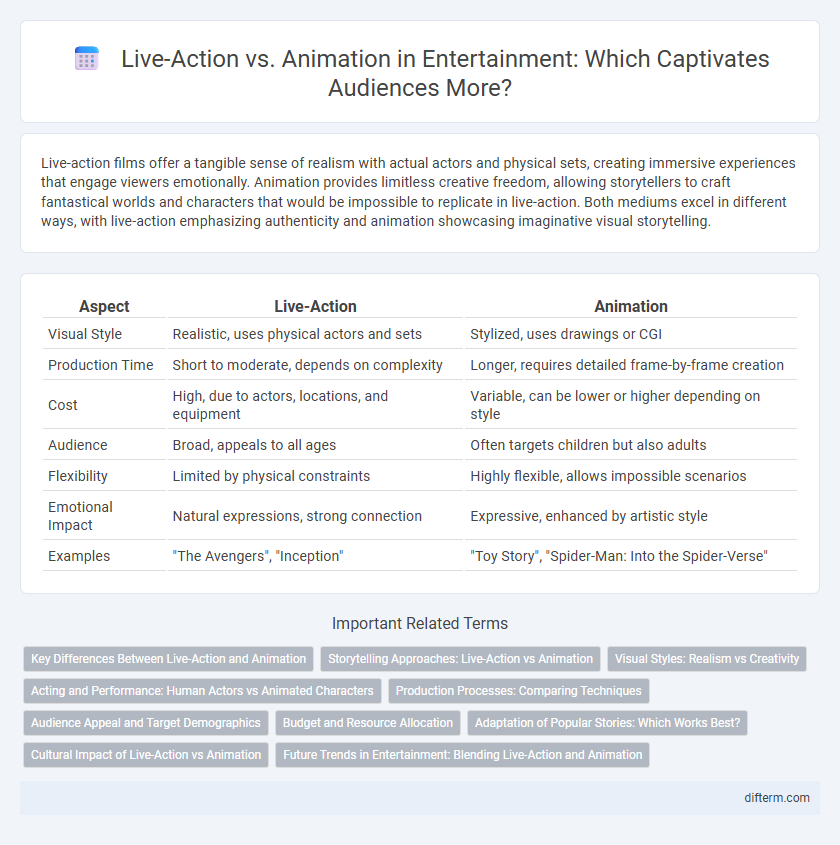Live-action films offer a tangible sense of realism with actual actors and physical sets, creating immersive experiences that engage viewers emotionally. Animation provides limitless creative freedom, allowing storytellers to craft fantastical worlds and characters that would be impossible to replicate in live-action. Both mediums excel in different ways, with live-action emphasizing authenticity and animation showcasing imaginative visual storytelling.
Table of Comparison
| Aspect | Live-Action | Animation |
|---|---|---|
| Visual Style | Realistic, uses physical actors and sets | Stylized, uses drawings or CGI |
| Production Time | Short to moderate, depends on complexity | Longer, requires detailed frame-by-frame creation |
| Cost | High, due to actors, locations, and equipment | Variable, can be lower or higher depending on style |
| Audience | Broad, appeals to all ages | Often targets children but also adults |
| Flexibility | Limited by physical constraints | Highly flexible, allows impossible scenarios |
| Emotional Impact | Natural expressions, strong connection | Expressive, enhanced by artistic style |
| Examples | "The Avengers", "Inception" | "Toy Story", "Spider-Man: Into the Spider-Verse" |
Key Differences Between Live-Action and Animation
Live-action features real actors and physical sets, offering authentic expressions and natural lighting, whereas animation creates scenes frame-by-frame using drawings, computer graphics, or stop-motion techniques, allowing for limitless creativity and stylized visuals. Animation permits exaggeration of movements and fantastical elements that live-action cannot physically achieve without extensive CGI. Budget-wise, live-action often demands higher costs for locations, actors, and equipment, while animation requires intensive labor in art and technology development.
Storytelling Approaches: Live-Action vs Animation
Live-action storytelling captures authentic human emotions and intricate performances, offering tangible settings that enhance audience immersion. Animation provides limitless creative freedom to craft fantastical worlds and exaggerated characters, enabling visually imaginative narratives that transcend physical reality. Both mediums employ unique visual techniques and pacing, shaping distinct viewer experiences and storytelling possibilities.
Visual Styles: Realism vs Creativity
Live-action films emphasize realism by capturing authentic human expressions, natural lighting, and tangible environments, providing audiences with a grounded visual experience. In contrast, animation allows for boundless creativity, using stylized designs, vibrant colors, and imaginative scenarios that transcend physical limitations. This visual flexibility enables animated works to explore surreal aesthetics and intricate details that live-action cannot easily replicate.
Acting and Performance: Human Actors vs Animated Characters
Human actors bring authentic emotions and nuanced facial expressions to live-action performances, creating a direct connection with audiences. Animated characters rely on skilled voice actors and animators to convey personality and emotion through visual artistry and vocal inflection. Advances in motion capture technology blend these approaches, enabling real actors' performances to drive animated characters with lifelike realism.
Production Processes: Comparing Techniques
Live-action production involves filming real actors and sets, requiring on-location shoots or soundstage setups, along with lighting, makeup, and practical effects coordination. Animation production uses techniques like hand-drawn frames, CGI modeling, or stop-motion, demanding extensive pre-visualization, storyboarding, and frame-by-frame rendering. While live-action emphasizes physical capture and real-time performance, animation relies heavily on post-production digital tools for visual effects and character movement.
Audience Appeal and Target Demographics
Live-action films often attract older audiences and those seeking realistic storytelling, as the visual authenticity and performances foster emotional connection. Animation appeals broadly to families and younger viewers, leveraging vibrant visuals and imaginative worlds that enhance engagement across age groups. Both formats strategically target demographics by aligning content style, themes, and character design with audience preferences and expectations.
Budget and Resource Allocation
Live-action productions typically require larger budgets due to expensive sets, location fees, and actor salaries, while animation allocates more funds to skilled artists, technology, and post-production processes. Resource allocation in live-action prioritizes physical logistics and on-set equipment, whereas animation emphasizes software, rendering hardware, and longer pre-production timelines. These budget differences impact scheduling flexibility and creative control, influencing the overall production strategy in entertainment projects.
Adaptation of Popular Stories: Which Works Best?
Live-action adaptations of popular stories offer a tangible connection to reality with human actors and real-world settings, enhancing emotional depth and relatability. Animation excels in bringing fantastical elements and imaginative worlds to life, unrestricted by physical limitations, making it ideal for intricate or visually complex narratives. Both formats succeed in adaptation by leveraging their unique strengths to engage audiences and faithfully convey the essence of beloved stories.
Cultural Impact of Live-Action vs Animation
Live-action films often resonate deeply with audiences by portraying real-world settings and human emotions, fostering cultural reflections and societal dialogue. Animation transcends physical limitations, allowing diverse storytelling that can embody cultural myths, traditions, and futuristic visions with universal appeal. Both mediums significantly influence pop culture, with live-action shaping social narratives and animation inspiring imagination and inclusivity across generations.
Future Trends in Entertainment: Blending Live-Action and Animation
Future entertainment trends reveal a growing integration of live-action and animation, leveraging advancements in CGI and real-time rendering technology. Hybrid productions enable richer storytelling by combining the emotional depth of live actors with limitless creative possibilities from animation. This blend is transforming genres, expanding audience engagement, and driving innovation in both film and streaming platforms.
live-action vs animation Infographic

 difterm.com
difterm.com